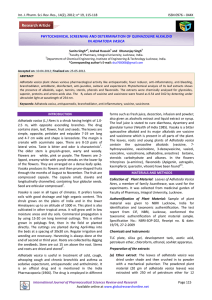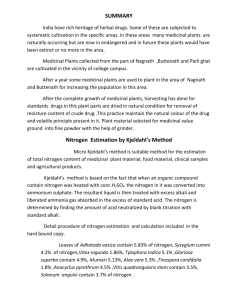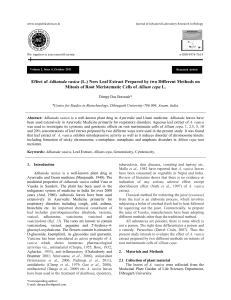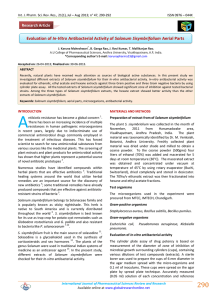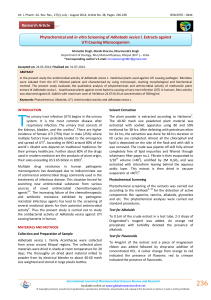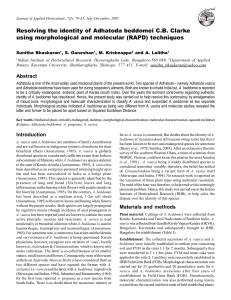Antibacterial Activity of Plant Extracts Against Respiratory Pathogens
advertisement
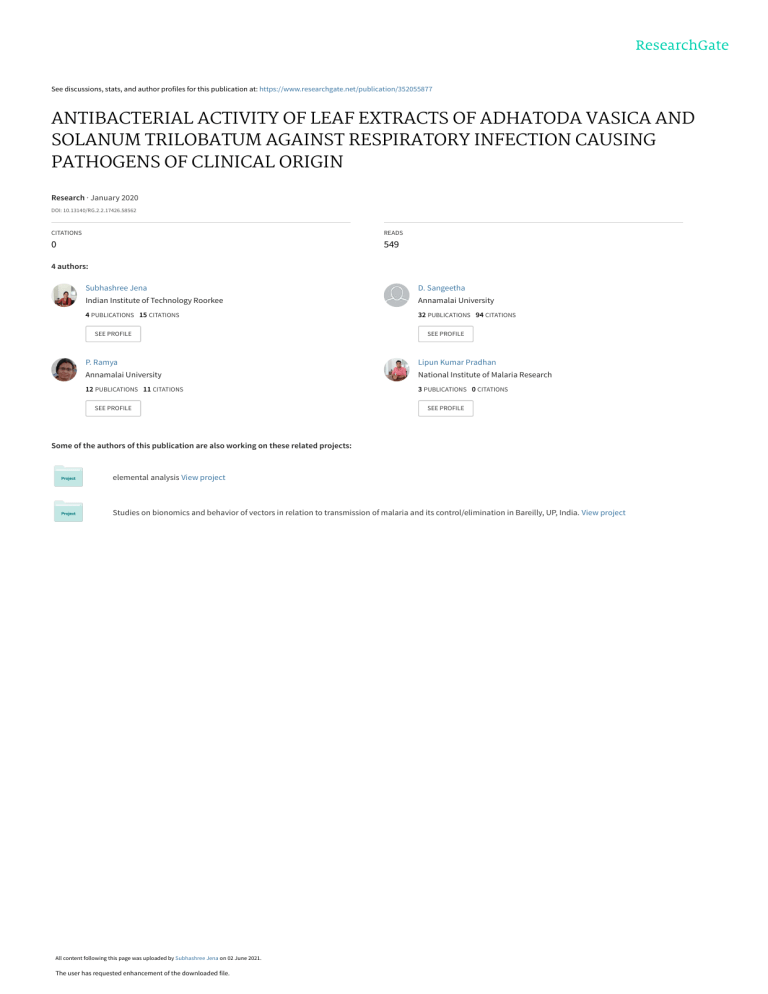
See discussions, stats, and author profiles for this publication at: https://www.researchgate.net/publication/352055877 ANTIBACTERIAL ACTIVITY OF LEAF EXTRACTS OF ADHATODA VASICA AND SOLANUM TRILOBATUM AGAINST RESPIRATORY INFECTION CAUSING PATHOGENS OF CLINICAL ORIGIN Research · January 2020 DOI: 10.13140/RG.2.2.17426.58562 CITATIONS READS 0 549 4 authors: Subhashree Jena D. Sangeetha Indian Institute of Technology Roorkee Annamalai University 4 PUBLICATIONS 15 CITATIONS 32 PUBLICATIONS 94 CITATIONS SEE PROFILE SEE PROFILE P. Ramya Lipun Kumar Pradhan Annamalai University National Institute of Malaria Research 12 PUBLICATIONS 11 CITATIONS 3 PUBLICATIONS 0 CITATIONS SEE PROFILE SEE PROFILE Some of the authors of this publication are also working on these related projects: elemental analysis View project Studies on bionomics and behavior of vectors in relation to transmission of malaria and its control/elimination in Bareilly, UP, India. View project All content following this page was uploaded by Subhashree Jena on 02 June 2021. The user has requested enhancement of the downloaded file. Int J Life Sci Pharma Res. ISSN 2250 – 0480; SP-07; “International Conference on Cancer Research” 2020. SP-09 ANTIBACTERIAL ACTIVITY OF LEAF EXTRACTS OF ADHATODA VASICA AND SOLANUM TRILOBATUM AGAINST RESPIRATORY INFECTION CAUSING PATHOGENS OF CLINICAL ORIGIN SUBHASHREE JENA, *D. SANGEETHA, P. RAMYA, LIPUN KUMAR PRADHAN Department of Microbiology, Faculty of Science, Annamalai University, Annamalai nagar - 608002, Tamilnadu, India. E-Mail: sangeethadau@gmail.com Abstract Plants are used for medicinal purposes from the prehistoric period. Traditional medicine continues to be broadly practised on several reasons. Rising population, scarcity of drugs, cost of treatments, side effects of synthetic drugs and development of resistance to currently using drugs have led to increased demand on the use of plant materials as a source of medicines for a wide variety of human ailments.The microbial pathogens enters into the human body through respiratory tract as the main portal. World Health Organization reports that respiratory tract infections like tuberculosis, influenza, and pneumonia caused more than 4 million deaths worldwide yearly. On account of such problems in the present study, various extracts of two medicinal plants namely Adhatoda vasica and Solanum trilobatum were chosen to evaluate the antibacterial activity against respiratory infection causing pathogens of clinical origin. Both of the plantsshowed antimicrobial activity against the respiratory infection causing microorganisms. The methanolic extract of Adhatoda vasica showed more activity when compared with the plant extract of Solanum trilobatum. Keywords: Adhatoda vasica, Solanum trilobatum,antibacterial activity 1. Introduction In recent years, the infectious diseases remain the leading cause of death worldwide and infections due to antibiotic resistant ability of some microorganisms. However, synthetic antimicrobial agents provide broad spectrum characteristics, but often associated with the adverse effects on the host, including immune suppression, hypersensitivity and several allergic responses1, 2, 3. Herbal medicine is the foundation for about 75–80% of the world population, mainly targeting primary health care in the developing countries because of better cultural acceptability, compatibility with human body and lesser side effects. However, there is a drastic increase in the usage of herbal medicine was found in last few years from the developed countries 4. Respiratory diseases, including allergies, asthma and chronic obstructive pulmonary disease (COPD) are a major public health burden worldwide. Each year, 250,000 people die of asthma. The prevalence of these diseases is increasing and there is a continued need for new and improved therapies. Some respiratory diseases are caused by bacteria. For instance, Staphylococcus aureus causes pneumonia 5, Escherichia coli causes community- acquired pneumonia6. Adhatoda vasica, native to Asia is a well-known plant in Siddha, Ayurveda and Unani systems of medicine. Various parts of this plant have been used to treat of several ailments as herbal remedy such as, cold, cough, whooping cough, chronic bronchitis, fever, jaundice asthma as sedative expectorant, diarrhoea and dysentery and rheumatic painful inflammatory swellings. This is one of the most potent anti-tuberculosis drugs 7. Solanum trilobatum Linn (Family: Solanaceae), a thorny creeper with bluish white flower and grows as a climbing under shrub. It is one of the important medicinal plants, more commonly available in Southern India and has been used in herbal medicine to treat various diseases like respiratory problems, bronchial asthma and tuberculosis8. www.ijlpr.com Page 51 Int J Life Sci Pharma Res. ISSN 2250 – 0480; SP-07; “International Conference on Cancer Research” 2020. 2. Materials and methods 2.1. Selection of medicinal plants In the present work, Adhatoda vasica and Solanum trilobatum plants were screened for potential antibacterial activity. Collection, Identification and Processing of Leaves of Adhatoda vasica and Solanum trilobatum Fresh plants were collected from Chidambaram, Cuddalore Dist, Tamilnadu. The taxonomic identities of these plants were determined. The leaves were washed with 70% alcohol and then rinsed with sterilized distilled water, shade dried for 10-12 days and powdered using mechanical grinder and then stored in air tight containers for further use. 2.2. 2.3. Preparation of crude leaf extracts The powdered materials used for the preparation of methanol, ethanol and acetone extracts. 2.3.1. Preparation of methanol extract 10 grams of leaf powder of each Adhatoda vasica and Solanum trilobatum were soaked in 100ml of methanol in conical flask separately, plugged with cotton and kept at room temperature for 3days and filtered through Whatman No:1 filter paper. The filtrate was evaporated in petri dish at room temperature for 2-3 days till the volume was reduced to one- fourth of the original volume of the solvent used and stored at4℃ in airtight bottles 9. 2.3.2. Preparation of ethanol extract 10 grams of leaf powder of each Adhatoda vasica and Solanum trilobatum were soaked in 100ml of ethanol in conical flask separately, plugged with cotton and kept at room temperature for 3 days and filtered through Whatman No:1 filter paper. The filtrate was evaporated in petri dish at room temperature for 2-3 days till the volume was reduced to one- fourth of the original volume of the solvent used and stored at 4℃ in airtight bottles 9. 2.3.3. Preparation of acetone extract 10 grams of leaf powder of each Adhatoda vasica and Solanum trilobatum were soaked in 100ml of acetone in conical flask separately, plugged with cotton and kept at room temperature for 3 days and filtered through Whatman No:1 filter paper. The filtrate was evaporated in petri dish at room temperature for 2-3 days till the volume was reduced to one- fourth of the original volume of the solvent used and stored at 4℃ in airtight bottles 9. 3ml of DMSO solvent was added to each bottle to dissolve the extracts. 2.4. Bacterial strain used for assay The bacterial cultures used in the study were procured from the Department of Microbiology, RMMCH, Annamalai University, Tamilnadu. The organisms used were Staphylococcus aureus, Pseudomonas aeruginosa, Escherichia coli, Proteus vulgaris, Streptococcus pyogenes, Klebsiella pneumoniae, Haemophilus influenzae. The strains were maintained on nutrient agar slant at 4℃ and sub cultured on nutrient agar slant and incubated at 37℃ for 24 hours before doing antimicrobial susceptibility test. 2.5. Agar disc diffusion method The inoculation of microbes was prepared from bacterial culture. About 15-20 ml of MullerHinton agar medium was poured in sterilized petridishes and allowed to solidify. One drop of bacterial strain was spread over the medium by swab plate method.Sterile discs were impregnated with the different concentration of solvent extracts of Adhatoda vasica like 25µl, 40µl and 50µl and of Solanum trilobatum like 25µl, 40µl and 50µl. The discs were allowed to dry and placed on the agar surface. The plates were incubated at 37℃ for 24 hours. The antibacterial activities were evaluated by measuring inhibition zone diameters at the end of the incubation period. 2.6. Phytochemical analysis The phytochemical analysis of the methanolic plant extract was carried out to find alkaloids, steroids, flavonoids, tannins, saponins and glycosides. www.ijlpr.com Page 52 Int J Life Sci Pharma Res. ISSN 2250 – 0480; SP-07; “International Conference on Cancer Research” 2020. 3. Results The bacterial cultures viz., Staphylococcus aureus, Pseudomonas aeruginosa, Escherichia coli, Proteus vulgaris, Streptococcus pyogenes, Klebsiella pneumoniae, Haemophilus influenzae procured from the Department of Microbiology, RMMCH, Annamalai University were tested against the ethanol, methanol and acetone extracts of A.vasica and Solanum trilobatum at different concentrations like 25µl,40µl,50µl concentrations. 3.1. Antibacterial Activity of Adhatoda vasica Against Clinical Pathogens: Methanolic extract of Adhatoda vasica showed maximum antibacterial activity against all the pathogens viz., Pseudomonas aeruginosa, Escherichia coli, Proteus vulgaris, Streptococcuspyogenes, Klebsiella pneumoniae, Haemophilus influenzae than the ethanol and acetone extracts except Staphylococcus aureus. Among all the organisms, maximum antibacterial activity was exhibited against the organisms in the order Proteus vulgaris, Staphylococcus aureus and Klebsiella pneumoniae. However, ethanol extract of Adhatoda vasica showed maximum antibacterial activity against Staphylococcus aureus than the other pathogens. Table-1: Antibacterial Activity of Adhatoda vasica Against Clinical Pathogens: SL. PATHOGENS Methanol 25µl 40µl No. 1. 2. 3. 4. 5. 6. 7. ZONE OF INHIBITION (mm) Staphylococcus 8±0.3 11±0.2 Aureus Pseudomonas 7±0.1 9±0.3 Aeruginosa Escherichia coli 6±0.1 7±0.2 Proteus vulgaris 11±0.2 13±0.3 Streptococcus 6±0.1 7±0.2 Pyogenes Klebsiella 8±0.2 11±0.3 pneumoniae Haemophilus 7±0.1 8±0.1 influenzae 50µl Ethanol 25µl 40µl 50µl Acetone 25µl 40µl 50µl 13±0.2 8±0.1 11±0.2 13±0.3 7±0.1 9±0.3 10±0.2 10±0.2 8±0.3 NZ 6±0.1 8±0.2 NZ 6±0.2 9±0.2 NZ 6±0.1 14±0.1 7±0.1 10±0.2 7±0.2 11±0.1 8±0.2 8±0.2 NZ 6±0.1 7±0.2 11±0.1 8±0.1 10±0.2 11±0.2 8±0.1 9±0.1 11±0.2 8±0.2 8±0.2 NZ 6±0.1 8±0.2 NZ 6±0.1 6±0.1 7±0.1 NZ 6±0.1 7±0.2 9±0.1 11±0.2 12±0.3 NZ= No Zone, ±SD 3.2. Antibacterial Activity of Solanum trilobatum against Clinical Pathogens Methanol extract of Solanum trilobatum showed maximum antibacterial activity against all the pathogens. The methanolic extract of Solanum trilobatum showed maximum zone of inhibition (12±0.3mm) against Proteus vulgaris followed by Klebsiella pneumoniae (11±0.3mm) in the concentration of 50 µl. The ethanolic and acetone extract showed highest inhibition against Staphylococcus aureus followed by Proteus vulgaris. Table-2: Antibacterial Activity of Solanum trilobatum against Clinical Pathogens Sl. Pathogens No. 1. 2. 3. 25µl Staphylococcus Aureus Pseudomonas aeruginosa Escherichia www.ijlpr.com Methanol 40µl 50µl zone of inhibition (mm) Ethanol Acetone 50µl 25µl 40µl 50µl 25µl 40µl 8±0.2 10±0.3 11±0.2 8±0.1 10±0.2 12±0.3 6±0.1 8±0.2 9±0.2 NZ 7±0.1 8±0.2 NZ 6±0.2 NZ 6±0.2 8±0.1 9±0.2 11±0.3 9±0.2 NZ 6±0.1 8±0.2 7±0.1 NZ 6±0.1 7±0.2 Page 53 Int J Life Sci Pharma Res. ISSN 2250 – 0480; SP-07; “International Conference on Cancer Research” 2020. Coli 4. 5. 6. 7. Proteus Vulgaris Streptococcus pyogenes Klebsiella pneumoniae Haemophilus influenzae 8±0.2 10±0.2 NZ 6±0.1 12±0.3 9±0.1 11±0.3 11±0.3 8±0.2 NZ 6±0.1 8±0.2 8±0.2 9±0.1 11±0.3 8±0.1 10±0.2 11±0.2 6±0.1 8±0.3 8±0.2 6±0.2 7±0.3 8±0.1 8±0.1 10±0.2 11±0.2 NZ 6±0.1 7±0.1 8±0.1 9±0.2 10±0.3 NZ 6±0.2 7±0.2 NZ= No Zone, ± SD 3.4. Phytochemical analysis of Methanolic Extractof Adhatoda vasica leaves The methanolic leaves extract of A. vasica has been analyzed for the presence of phytochemicals. From the Table-3 it can be observed that the methanolic extract of A. vasica leaves contain phytochemicals such as alkaloids, flavonoids, tannins and saponins. Table-3: Phytochemical analysis of Methanolic Extract of Adhatoda vasica Leaves S. No Phytochemicals Methanol Extract of A. vasica 1. 2. 3. 4. 5. 6. Alkaloids a. Dragendorff’s test + b. Mayer’s test Steroids Flavonoids Tannis Saponins Glycosides + + + + a.Borntrager’s test - 4. Discussion The bacterial strains used in the present study were Staphylococcu saureus, Proteus vulgaris, Escherichia coli, Streptococcus pyogenes, Pseudomonas aeruginosa, Haemophilus influenzae and Klebsiella pneumoniae for both the plants were taken from Department of Microbiology, RMMCH, Annamalai University and the sub-cultures were maintained at 4°C in nutrient agar slant. Zabta Khan Shinwari et al., 2009 10 had used Gram-positive bacteria, Staphylococcus aureus, Bacillus subtilis, Gram-negative bacteria, Pseudomonas aeruginosa, Escherichia coli and S. typhimurium against Adhatoda vasica and the cultures were obtained from culture library of Microbiology Laboratory of QRI. They also maintained the sub-culture at 4°C but in agar broth. Sankar Kumar et al., 11 revealed that Adhatoda vasica showed the antimicrobial activity against Staphylococcus aureus, Streptococcus pyogens, Escherichia coli, Pseudomonas aeruginosa, Proteus vulgaris and Klebsiella pneumoniae which also exhibited the highest activity in methanol extract than the aqueous extract. This is an agreement with the current study (i.e.) the methanol extract of Adhatoda vasica exhibited high activity against the tested organisms rather than ethanol and acetone extract of Adhatoda vasica. In the present study, the methanolic extracts of leaves of Adhatoda vasica showed highest antibacterial activity against the clinical pathogens than the ethanol and acetone extracts. Swapna Latha and Kannabiran, 12revealed that Aqueous extract from of S. trilobatum leaves showed antibacterial activity against tested bacterial strains in the order of Klebsiella (10 mm; MIC-0.63 www.ijlpr.com Page 54 Int J Life Sci Pharma Res. ISSN 2250 – 0480; SP-07; “International Conference on Cancer Research” 2020. mg/ml), B. subtilis (9 mm; MIC-0.5 mg/ml), and S. aureus (8 mm;MIC0.5mg/ml). Methanol extracts of flowers showed inhibition over E.coli (11mm) and S. aureus (9 mm) whereas stem extract showed inhibition only against S. aureus (11 mm). In the present study, Methanol extract of Solanum trilobatum showed maximum antibacterial activity against all the bacterial strains. Mohmed Yusuf and Shafat Ahmad Khan, 13had analyzed the leaves extracts (ethanol, acetone, ethyl acetate and petroleum ether) of A. vasica for the presence of phytochemicals. It can be observed that the extracts of A.vasica leaves, contain phytochemicals such as alkaloids, flavonoids, terpenoids, tannins and saponins. Therefore, tannins and saponins were observed in ethanol and petroleum ether extracts only. In present study, the methanolic leaves extract of A. vasica has been analyzed for the presence of phytochemicals. It can be observed that the methanolic extract of A.vasica leaves, contain phytochemicals such as, alkaloids, flavonoids, tannins and saponins. 5. Conclusion In the present study, both Adhatoda vasica and Solanum trilobatum showed antimicrobial activity against the respiratory infection causing microorganisms. Hence there could be probability to use these extracts for the treatment of bacterial infectious diseases, as these are eco-safe and biodegradable. Reference 1. 2. 3. 4. 5. 6. 7. 8. 9. 10. 11. 12. 13. Selvakumar, S. Preliminary phytochemical analysis of aerial parts of Crossandra infundibuliformis, J. Chem. Pharmaceut. Res., 2015, 7(12):784-787. Ahmad, Z. Mehmood, F. Mohammad. J. Screening of some Indian medicinal plants for their antimicrobial properties.Ethnopharmacol., 1998, 183-193. Yusuf, A. Ahmad, M. Shahid, M.I. Khan, S.A. Khan, N. Manzoor, F. Mohammad. Assessment of colorimetric, antibacterial and antifungal properties of woollen yarn dyed with the extract of the leaves of henna (Lawsonia inermis), J. Clean. Prod., 2012, 42-50. Vethanarayanan P, Unnikannan P, Baskaran L, Sundaramoorthy P. Asi.J.Biochem. Solanum trilobatum (Solanaceae) - an overview, Pharma. Res., 2011, 351–361. Rubinstein E, Kollef M H, Nathwani D., Pneumonia caused by methicillin resistant Staphylococcus aureus. Clin. Infect Dis., 2008, 378-385. Tillotson JR, Lerner AM., Characteristics of pneumonias caused by Escherichiacoli. N. Engl. J. Med., 1967, 115-122. Chopra. Indigenous Drugs of India. Academic Publishers, Kolkata, India, 1982. Ramakrishnan Akshara, Chandrasekaran Elakiya, Peraman Muthukumaran and Nachimuthu Saraswathy., Comparative evaluation of antibacterial, antifungal activity and phytochemical screening of leaf and bark extract of Solanum trilobatum L., Journal of Chemical and Pharmaceutical Research, 2016, 198-202. Harbone JB., Phytochemical Methods. London: Chapman and Hill, 1973, 17. Zabta Khan Shinwari, Irfan Khan, Shamma Naz and Altaf Hussain., Assessment of antibacterial activity of three plants used in Pakistan to cure respiratory diseases, African Journal of Biotechnology., 2009, 7082-7086. Josephin Sheeba.B and Selva Mohan. T., Antimicrobial activity of Adhatoda vasica against clinical pathogens, Asian Journal of Plant Science and Research, 2012, 83-88. Inderjit Kaur, P.K. Chauhan, Munish Jaryal, Shubham Saxena and Kanishak., Antioxidant and Antimicrobial activity of leaf extract of Adhatoda vasica against the bacteria isolated from the sputum samples of Asthmatic patients, Int. J. Drug Res. Tech., 2012,273-278. Swapna Latha P and Kannabiran K., Antimicrobial activity and phytochemicals of Solanum trilobatum Linn., African Journal of Biotechnology., 2006, 2402-2404. www.ijlpr.com View publication stats Page 55
